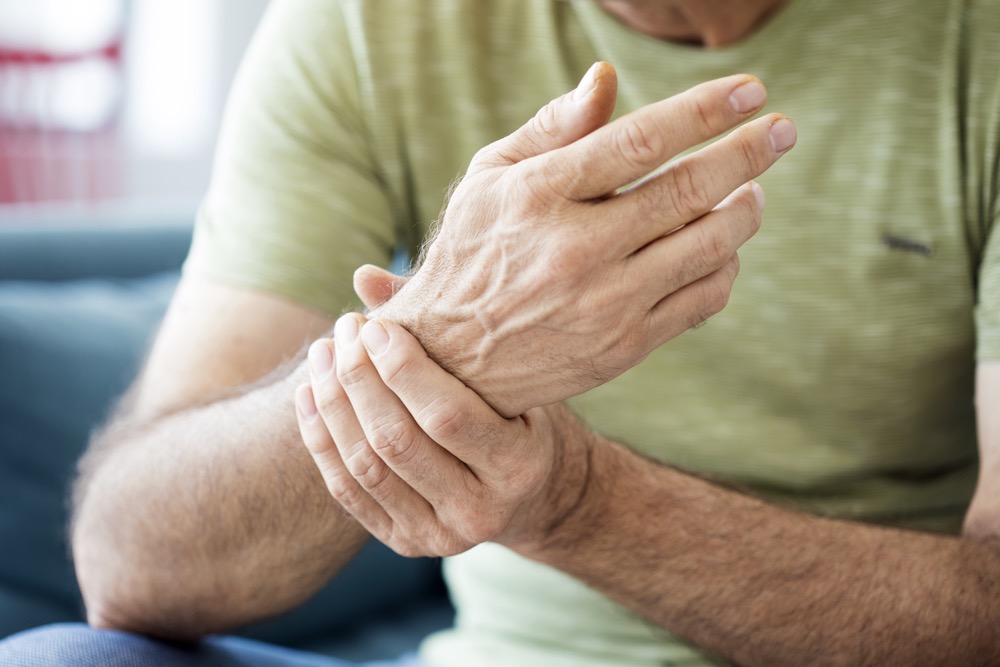Ganglion Cyst in Westchester county, NY

A ganglion cyst is a fluid-filled sac that usually forms on top of a tendon or the covering of a joint in the wrist or hand. It is the most common type of soft-tissue growth in the wrist or hand, and can develop suddenly or over time. Although usually benign and harmless, it can put pressure on nearby nerves, potentially causing pain, weakness or numbness. The cause of a ganglion cyst is unknown, although it tends to occur in people who have osteoarthritis, and in women between the ages of 25 and 45. They often develop when the soft sheath around a tendon or joint swells and fills with mucus.
Signs of a Ganglion Cyst
A ganglion cyst presents as a small raised lump that is filled with gelatinous fluid. Specific locations that a ganglion cyst develops are the back of the wrist (most common), the front of the wrist, behind a fingernail or on the palm at the base of a finger.
- Location. Ganglion cysts most often develop along the tendons or joints of wrists or hands. The next most common locations are the ankles and feet. These cysts grow near other joints, too.
- Shape and size. Ganglion cysts are round or oval. Some are too small to feel. The size of a cyst can change, often getting larger over time with joint movement.
- Pain. Ganglion cysts usually are painless. But if a cyst presses on a nerve or other structures, it can cause pain, tingling, numbness, or muscle weakness.
Who Is Most At Risk for Developing a Ganglion Cyst?
Ganglion cysts are common among people with osteoarthritis, but they may also be more likely to develop in:
- Women between the ages of 25 and 45
- People who have suffered from joint or tendon injury
- Young children up to the age of 15. Young girls are more likely to develop ganglion cysts than young boys.
What Not To Do When You Have a Ganglion Cyst
While ganglion cysts can disappear on their own over time, some patients may believe that certain at-home treatments and activities can help them get rid of them. However, oftentimes, these practices can lead to more pain.
Avoid trying to rupture the cyst. Many people believe it can be drained at home. However, this may cause it to become infected. Hitting the cyst with a heavy object or trying to flatten it can also cause excess pain and increase your risk of injury. While massaging a ganglion cyst does have some benefits, it’s important to remember that if your cyst does not disappear on its own, it may be time to schedule an appointment for treatment.
When Do I Need to See a Doctor for My Ganglion Cyst?
When a ganglion cyst appears on a patient, it is first recommended to try the “wait and see” approach. Waiting several days can show whether or not your ganglion cyst will disappear on its own. If, during this time, your cyst begins to hurt, feel numb, and tingly, or prevent you from using your joints in simple ways, seek treatment from an orthopaedic expert.
Treatment for a Ganglion Cyst
Treatment for a ganglion cyst is called for only if it is causing painful symptoms, although a person may choose to treat it for cosmetic reasons. A ganglion cyst can also go away on its own. Depending on its size and the severity of the symptoms it is causing, a ganglion cyst can be treated in the following ways:
Aspiration
Aspiration is a minimally invasive procedure in which the fluid inside the cyst is drained using a syringe. Aspiration may be combined with a steroid injection, which reduces inflammation. The wrist may be immobilized with a splint, although this is becoming less common because recent studies indicate that splinting offers no real benefit.
Surgery
Surgery may be recommended for a cyst that is very painful, interferes with joint movement, or causes tingling or numbness. Ganglion cyst surgery is performed under local anesthetic; it involves complete removal of the cyst and any attached tissue. Physical therapy may be recommended after surgery in order to rehabilitate the hand or wrist.
A ganglion cyst tends to return less frequently when it is surgically removed rather than merely aspirated.
Helpful Information to Share at Your Appointment
When it comes to seeking treatment for your ganglion cyst, asking the right questions can help you and your PA at Specialty Orthopedics determine the best treatment option for you. While monitoring your cyst, make notes of any changes and important information to share with your PA. This information can include the following:
- How long have you had the cyst?
- Has it grown in size?
- Has it felt different?
- Do you feel joint pain or arthritis symptoms in other areas of your body?
Schedule Your Appointment Today
If you are experiencing symptoms of ganglion cyst, visit Specialty Orthopaedics. Our New York orthopedic practice is home to a team of fellowship-trained orthopedists in a variety of orthopedic specialty areas. We offer comprehensive treatment for musculoskeletal disorders in a caring and responsive clinical atmosphere. Give us a call at 914.686.0111 or fill out the form on this page to schedule your appointment today.








